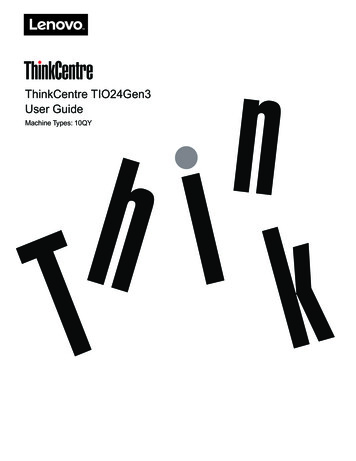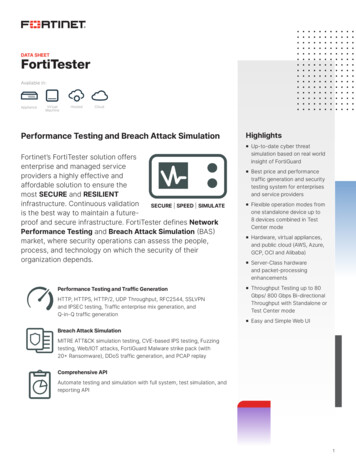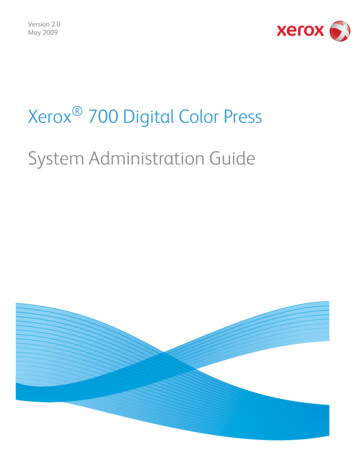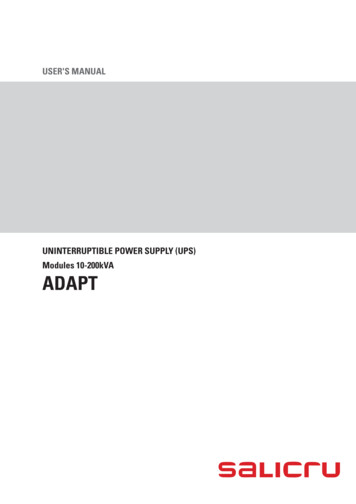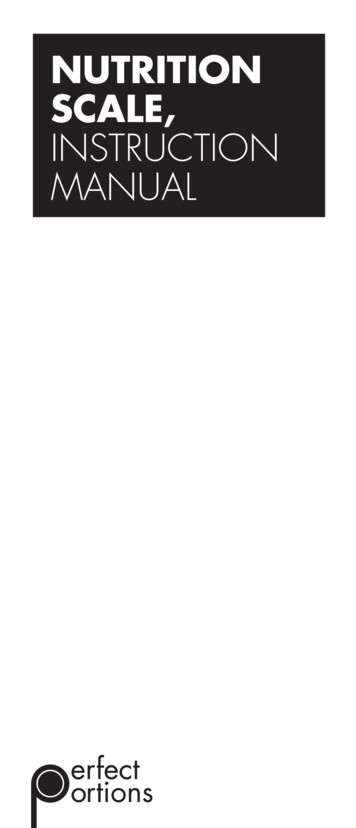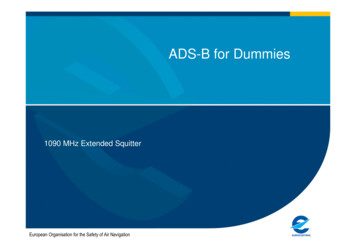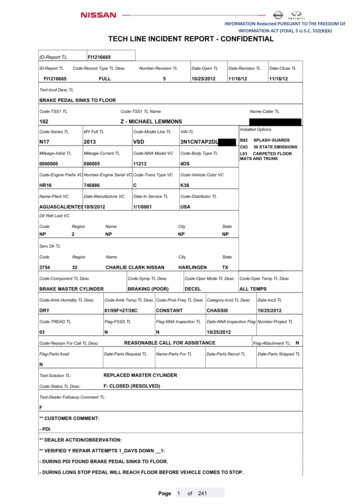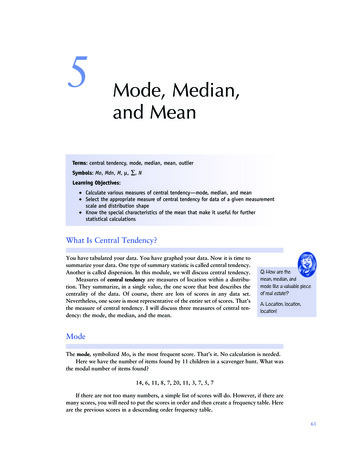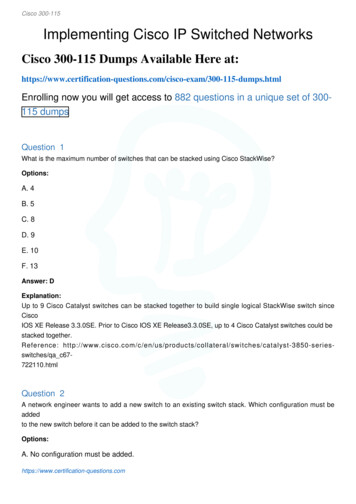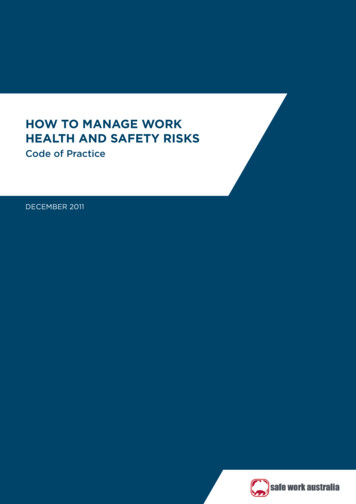
Transcription
HOW TO MANAGE WORKHEALTH AND SAFETY RISKSCode of PracticeDECEMBER 2011
Safe Work Australia is an Australian Government statutory agency established in 2009.Safe Work Australia consists of representatives of the Commonwealth, state and territorygovernments, the Australian Council of Trade Unions, the Australian Chamber of Commerce andIndustry and the Australian Industry Group.Safe Work Australia works with the Commonwealth, state and territory governments to improvework health and safety and workers’ compensation arrangements. Safe Work Australia is a nationalpolicy body, not a regulator of work health and safety. The Commonwealth, states and territorieshave responsibility for regulating and enforcing work health and safety laws in their jurisdiction.ISBN 978-0-642-33301-8 [PDF]ISBN 978-0-642-33302-5 [RTF]Creative CommonsExcept for the logos of Safe Work Australia, SafeWork SA, WorkSafe Tasmania, WorkSafe WA,Workplace Health and Safety QLD, NT WorkSafe, WorkCover NSW, Comcare and WorkSafe ACT,this copyright work is licensed under a Creative Commons Attribution-Noncommercial 3.0 Australialicence. To view a copy of this licence, visitcreativecommons.org/licensesIn essence, you are free to copy, communicate and adapt the work for non commercial purposes, aslong as you attribute the work to Safe Work Australia and abide by the other licence terms.Contact informationSafe Work AustraliaPhone: 1300 551 832Email: info@swa.gov.auWebsite: safeworkaustralia.gov.au
TABLE OF CONTENTSFOREWORD21.INTRODUCTION31.1Who has responsibility for managingwork health and safety risks?31.2The meaning of key terms41.3What is involved in managing risks?41.4When should a risk managementapproach be used?62.STEP 1 – HOW TO IDENTIFY HAZARDS72.1How to find hazards83.STEP 2 – HOW TO ASSESS RISKS93.1When should a risk assessment becarried out?93.2 How to do a risk assessment104.STEP 3 – HOW TO CONTROL RISKS134.1The hierarchy of risk control134.2 How to develop and implementcontrol options154.3 How to ensure that controls remain effective175.STEP 4 – HOW TO REVIEW CONTROLS186.KEEPING RECORDS19APPENDIX A – ASSESSING HOW THINGS GOWRONG20APPENDIX B – RISK REGISTER21APPENDIX C – CASE STUDIES22CODE OF PRACTICE HOW TO MANAGE WORK HEALTH AND SAFETY RISKS1
FOREWORDThis Code of Practice on how to manage work health and safety risks is an approved codeof practice under section 274 of the Work Health and Safety Act (the WHS Act).An approved code of practice is a practical guide to achieving the standards of health, safetyand welfare required under the WHS Act and the Work Health and Safety Regulations (theWHS Regulations).A code of practice applies to anyone who has a duty of care in the circumstancesdescribed in the code. In most cases, following an approved code of practice would achievecompliance with the health and safety duties in the WHS Act, in relation to the subjectmatter of the code. Like regulations, codes of practice deal with particular issues and do notcover all hazards or risks that may arise. The health and safety duties require duty holdersto consider all risks associated with work, not only those for which regulations and codes ofpractice exist.Codes of practice are admissible in court proceedings under the WHS Act and Regulations.Courts may regard a code of practice as evidence of what is known about a hazard, riskor control and may rely on the code in determining what is reasonably practicable in thecircumstances to which the code relates.Compliance with the WHS Act and Regulations may be achieved by following anothermethod, such as a technical or an industry standard, if it provides an equivalent or higherstandard of work health and safety than the code.An inspector may refer to an approved code of practice when issuing an improvementor prohibition notice.This Code of Practice has been developed by Safe Work Australia as a model code ofpractice under the Council of Australian Governments’ Inter-Governmental Agreement forRegulatory and Operational Reform in Occupational Health and Safety for adoption by theCommonwealth, state and territory governments.A draft of this Code of Practice was released for public consultation on 7 December 2010and was endorsed by the Workplace Relations Ministers’ Council on 10 August 2011.SCOPE AND APPLICATIONThis Code provides practical guidance for persons who have duties under the WHS Act andRegulations to manage risks to health and safety. The duty is placed on persons conductinga business or undertaking, including employers, self-employed, principal contractors, personswith management or control of a workplace, designers, manufacturers, importers andsuppliers of plant, substances or structures that are used for work.This Code applies to all types of work and all workplaces covered by the WHS Act. Otherapproved codes of practice should be referenced for guidance on managing the risk ofspecific hazards.HOW TO USE THIS CODE OF PRACTICEIn providing guidance, the word ‘should’ is used in this Code to indicate a recommendedcourse of action, while ‘may’ is used to indicate an optional course of action.This Code also includes various references to sections of the WHS Act and to regulationswhich set out the legal requirements. These references are not exhaustive. The words ‘must’,‘requires’ or ‘mandatory’ indicate that a legal requirement exists and must be complied with.2CODE OF PRACTICE HOW TO MANAGE WORK HEALTH AND SAFETY RISKS
1. INTRODUCTION1.1Who has responsibility for managing work healthand safety risks?The WHS Act and Regulations require persons who have a duty to ensure health and safetyto ‘manage risks’ by eliminating health and safety risks so far as is reasonably practicable,and if it is not reasonably practicable to do so, to minimise those risks so far as is reasonablypracticable.Persons conducting a business or undertaking will have health and safety duties to managerisks if they: engage workers to undertake work for them, or if they direct or influence work carried outby workers may put other people at risk from the conduct of their business or undertaking manage or control the workplace or fixtures, fittings or plant at the workplace design, manufacture, import or supply plant, substances or structures for use at aworkplace install, construct or commission plant or structures at a workplace.Deciding what is ‘reasonably practicable’ to protect people from harm requires taking intoaccount and weighing up all relevant matters, including: the likelihood of the hazard or risk concerned occurring the degree of harm that might result from the hazard or risk knowledge about the hazard or risk, and ways of eliminating or minimising the risk the availability and suitability of ways to eliminate or minimise the risk, and after assessing the extent of the risk and the available ways of eliminating or minimisingthe risk, the cost associated with available ways of eliminating or minimising the risk,including whether the cost is grossly disproportionate to the risk.The process of managing risk described in this Code will help you decide what is reasonablypracticable in particular situations so that you can meet your duty of care under theWHS laws.Officers (for example company directors) must exercise due diligence to ensure that thebusiness or undertaking complies with the WHS Act and Regulations. This includes takingreasonable steps to: gain an understanding of the hazards and risks associated with the operations of thebusiness or undertaking ensure that the business or undertaking has and uses appropriate resources and processesto eliminate or minimise risks to health and safety.A person can have more than one duty and more than one person can have the same dutyat the same time.CODE OF PRACTICE HOW TO MANAGE WORK HEALTH AND SAFETY RISKS3
1. INTRODUCTION1.2The meaning of key termsHazard means a situation or thing that has the potential to harm a person. Hazards at workmay include: noisy machinery, a moving forklift, chemicals, electricity, working at heights, arepetitive job, bullying and violence at the workplace.Risk is the possibility that harm (death, injury or illness) might occur when exposed to ahazard.Risk control means taking action to eliminate health and safety risks so far as is reasonablypracticable, and if that is not possible, minimising the risks so far as is reasonably practicable.Eliminating a hazard will also eliminate any risks associated with that hazard.1.3What is involved in managing risks?MANAGEMENT COMMITMENTEffective risk management starts with a commitment to health and safety from those whooperate and manage the business or undertaking. You also need the involvement andcooperation of your workers, and if you show your workers that you are serious about healthand safety they are more likely to follow your lead.To demonstrate your commitment, you should: get involved in health and safety issues invest time and money in health and safety ensure health and safety responsibilities are clearly understood.A STEP-BY-STEP PROCESSA safe and healthy workplace does not happen by chance or guesswork. You have to thinkabout what could go wrong at your workplace and what the consequences could be. Thenyou must do whatever you can (in other words, whatever is ‘reasonably practicable’) toeliminate or minimise health and safety risks arising from your business or undertaking.This process is known as risk management and involves the four steps set out in this Code(see Figure 1 to the right): identify hazards – find out what could cause harm assess risks if necessary – understand the nature of the harm that could be caused by thehazard, how serious the harm could be and the likelihood of it happening control risks – implement the most effective control measure that is reasonably practicablein the circumstances review control measures to ensure they are working as planned.4CODE OF PRACTICE HOW TO MANAGE WORK HEALTH AND SAFETY RISKS
1. INTRODUCTIONFIGURE 1The risk management processMany hazards and their associated risks are well known and have well established andaccepted control measures. In these situations, the second step to formally assess the riskis unnecessary. If, after identifying a hazard, you already know the risk and how to control iteffectively, you may simply implement the controls.Risk management is a proactive process that helps you respond to change and facilitatecontinuous improvement in your business. It should be planned, systematic and cover allreasonably foreseeable hazards and associated risks.CONSULTING YOUR WORKERSSection 47The WHS Act requires that you consult, so far as is reasonably practicable, with workerswho carry out work for you who are (or are likely to be) directly affected by a workhealth and safety matter.Section 48If the workers are represented by a health and safety representative, the consultationmust involve that representative.Consultation involves sharing of information, giving workers a reasonable opportunity toexpress views and taking those views into account before making decisions on health andsafety matters.Consultation with workers and their health and safety representatives is required at eachstep of the risk management process. By drawing on the experience, knowledge and ideasof your workers you are more likely to identify all hazards and choose effective controlmeasures.CODE OF PRACTICE HOW TO MANAGE WORK HEALTH AND SAFETY RISKS5
1. INTRODUCTIONYou should encourage your workers to report any hazards and health and safety problemsimmediately so that risks can be managed before an incident occurs.If you have a health and safety committee, you should engage the committee in the riskmanagement process as well.CONSULTING, CO-OPERATING AND CO-ORDINATING ACTIVITIES WITH OTHER DUTYHOLDERSSection 46The WHS Act requires that you consult, co-operate and co-ordinate activities with allother persons who have a work health or safety duty in relation to the same matter,so far as is reasonably practicable.Sometimes you may share responsibility for a health and safety matter with other businessoperators who are involved in the same activities or who share the same workplace. Forexample, if you engage on-hire workers as part of your workforce you share a duty of careto these workers with the business that provides them. In these situations, you must discussthe hazards and risks associated with the work and what precautions will be taken with theon-hire firm.Never assume that someone else is taking care of a health and safety matter. Find out whois doing what and work together with other duty holders in a co-operative and co-ordinatedway so that all risks are eliminated or minimised as far as reasonably practicable.When entering into contracts you should communicate your safety requirements andpolicies, review the job to be undertaken, discuss any safety issues that may arise and howthey will be dealt with. Remember that you cannot transfer your responsibilities to anotherperson.Further guidance on consultation is available in the Code of Practice: Work Health and SafetyConsultation, Co-operation and Co-ordination.1.4When should a risk management approachbe used?Managing work health and safety risks is an ongoing process that is triggered when anychanges affect your work activities. You should work through the steps in this Code when: starting a new business or purchasing a business changing work practices, procedures or the work environment purchasing new or used equipment or using new substances planning to improve productivity or reduce costs new information about workplace risks becomes available responding to workplace incidents (even if they have caused no injury) responding to concerns raised by workers, health and safety representatives or others atthe workplace required by the WHS regulations for specific hazardsIt is also important to use the risk management approach when designing and planningproducts, processes or places used for work, because it is often easier and more effectiveto eliminate hazards before they are introduced into a workplace by incorporating safetyfeatures at the design stage.6CODE OF PRACTICE HOW TO MANAGE WORK HEALTH AND SAFETY RISKS
2. STEP 1 – HOW TO IDENTIFY HAZARDSIdentifying hazards in the workplace involves finding things and situations that couldpotentially cause harm to people. Hazards generally arise from the following aspects of workand their interaction: physical work environment equipment, materials and substances used work tasks and how they are performed work design and managementTable 1 below lists some common types of workplace hazards. Some hazards are part ofthe work process, such as mechanical hazards, noise or toxic properties of substances.Other hazards result from equipment or machine failures and misuse, chemical spills andstructural failures.A piece of plant, substance or a work process may have many different hazards. Each ofthese hazards needs to be identified. For example, a production line may have dangerousmoving parts, noise, hazards associated with manual tasks and psychological hazards dueto the pace of work.Table 1 Examples of common hazardsHazardPotential harmManual tasksOverexertion or repetitive movement can causemuscular strainGravityFalling objects, falls, slips and trips of people cancause fractures, bruises, lacerations, dislocations,concussion, permanent injuries or deathElectricityPotential ignition source.Exposure to live electrical wires can cause shock,burns or death from electrocutionMachinery and equipmentBeing hit by moving vehicles, or being caught bymoving parts of machinery can cause fractures,bruises, lacerations, dislocations, permanentinjuries or deathHazardous chemicalsChemicals (such as acids, hydrocarbons, heavymetals) and dusts (such as asbestos and silica)can cause respiratory illnesses, cancers ordermatitisExtreme temperaturesHeat can cause burns, heat stroke or fatigueCold can cause hypothermia or frost biteNoiseExposure to loud noise can cause permanenthearing damageRadiationUltra violet, welding arc flashes, micro waves andlasers can cause burns, cancer or blindnessBiologicalMicro-organisms can cause hepatitis,legionnaires’ disease, Q fever, HIV/AIDS orallergiesPsychosocial hazardsEffects of work-related stress, bullying, violenceand work-related fatigueCODE OF PRACTICE HOW TO MANAGE WORK HEALTH AND SAFETY RISKS7
2. STEP 1 - HOW TO IDENTIFY HAZARDS2.1How to find hazardsINSPECT THE WORKPLACERegularly walking around the workplace and observing how things are done can help youpredict what could or might go wrong. Look at how people actually work, how plant andequipment is used, what chemicals are around and what they are used for, what safe orunsafe work practices exist as well as the general state of housekeeping.Things to look out for include the following: Does the work environment enable workers to carry out work without risks to health andsafety (for example, space for unobstructed movement, adequate ventilation, lighting)? How suitable are the tools and equipment for the task and how well are they maintained? Have any changes occurred in the workplace which may affect health and safety?Hazards are not always obvious. Some hazards can affect health over a long period of timeor may result in stress (such as bullying) or fatigue (such as shiftwork). Also think abouthazards that you may bring into your workplace as new, used or hired goods (for example,worn insulation on a hired welding set).As you walk around, you may spot straightforward problems and action should be takenon these immediately, for example cleaning up a spill. If you find a situation where there isimmediate or significant danger to people, move those persons to a safer location first andattend to the hazard urgently.Make a list of all the hazards you can find, including the ones you know are already beingdealt with, to ensure that nothing is missed. You may use a checklist designed to suit yourworkplace to help you find and make a note of hazards.CONSULT YOUR WORKERSAsk your workers about any health and safety problems they have encountered in doing theirwork and any near misses or incidents that have not been reported.Worker surveys may also be undertaken to obtain information about matters such asworkplace bullying, as well as muscular aches and pains that can signal potential hazards.REVIEW AVAILABLE INFORMATIONInformation and advice about hazards and risks relevant to particular industries and typesof work is available from regulators, industry associations, unions, technical specialists andsafety consultants.Manufacturers and suppliers can also provide information about hazards and safetyprecautions for specific substances (safety data sheets), plant or processes (instructionmanuals).Analyse your records of health monitoring, workplace incidents, near misses, workercomplaints, sick leave and the results of any inspections and investigations to identifyhazards. If someone has been hurt doing a particular task, then a hazard exists that couldhurt someone else. These incidents need to be investigated to find the hazard that causedthe injury or illness.8CODE OF PRACTICE HOW TO MANAGE WORK HEALTH AND SAFETY RISKS
3. STEP 2 – HOW TO ASSESS RISKA risk assessment involves considering what could happen if someone is exposed to ahazard and the likelihood of it happening. A risk assessment can help you determine: how severe a risk is whether any existing control measures are effective what action you should take to control the risk how urgently the action needs to be taken.A risk assessment can be undertaken with varying degrees of detail depending on the typeof hazards and the information, data and resources that you have available. It can be assimple as a discussion with your workers or involve specific risk analysis tools and techniquesrecommended by safety professionals.3.1When should a risk assessment be carried out?A risk assessment should be done when: there is uncertainty about how a hazard may result in injury or illness the work activity involves a number of different hazards and there is a lack ofunderstanding about how the hazards may interact with each other to produce new orgreater risks changes at the workplace occur that may impact on the effectiveness of control measures.A risk assessment is mandatory under the WHS Regulations for high risk activities such asentry into confined spaces, diving work and live electrical work.Some hazards that have exposure standards, such as noise and airborne contaminants, mayrequire scientific testing or measurement by a competent person to accurately assess therisk and to check that the relevant exposure standard is not being exceeded (for example,by using noise meters to measure noise levels and using gas detectors to analyse oxygenlevels in confined spaces).A risk assessment is not necessary in the following situations: Legislation requires some hazards or risks to be controlled in a specific way – theserequirements must be complied with. A code of practice or other guidance sets out a way of controlling a hazard or risk thatis applicable to your situation and you choose to use the recommended controls. In theseinstances, the guidance can be followed. There are well-known and effective controls that are in use in the particular industry,that are suited to the circumstances in your workplace. These controls can simplybe implemented.CODE OF PRACTICE HOW TO MANAGE WORK HEALTH AND SAFETY RISKS9
3. STEP 2 - HOW TO ASSESS RISKS3.2How to do a risk assessmentAll hazards have the potential to cause different types and severities of harm, ranging fromminor discomfort to a serious injury or death.For example, heavy liquefied petroleum gas (LPG) cylinders can cause muscular strain whenthey are handled manually. However, if the cylinder is damaged causing gas to leak which isthen ignited, a fire could result in serious burns. If that leak occurs in a store room or similarenclosed space, it could result in an explosion that could destroy the building and kill orinjure anyone nearby. Each of the outcomes involves a different type of harm with a range ofseverities, and each has a different likelihood of occurrence.WORK OUT HOW SEVERE THE HARM COULD BETo estimate the severity of harm that could result from each hazard you should consider thefollowing questions: What type of harm could occur (e.g. muscular strain, fatigue, burns, laceration)? Howsevere is the harm? Could the hazard cause death, serious injuries, illness or only minorinjuries requiring first aid? What factors could influence the severity of harm that occurs? For example, the distancesomeone might fall or the concentration of a particular substance will determine the levelof harm that is possible. The harm may occur immediately something goes wrong (e.g.injury from a fall) or it may take time for it to become apparent (e.g. illness from long-termexposure to a substance). How many people are exposed to the hazard and how many could be harmed in andoutside your workplace? For example, a mobile crane collapse on a busy construction sitehas the potential to kill or injure a large number of people. Could one failure lead to other failures? For example, could the failure of your electricalsupply make any control measures that rely on electricity ineffective? Could a small event escalate to a much larger event with more serious consequences? Forexample, a minor fire can get out of control quickly in the presence of large amounts ofcombustible materials.WORK OUT HOW HAZARDS MAY CAUSE HARMIn most cases, incidents occur as a result of a chain of events and a failure of one or morelinks in that chain. If one or more of the events can be stopped or changed, the risk may beeliminated or reduced.One way of working out the chain of events is to determine the starting point where thingsbegin to go wrong and then consider: ‘If this happens, what may happen next?’ This willprovide a list of events that sooner or later cause harm. See the case study in Appendix A.In thinking about how each hazard may cause harm, you should consider: the effectiveness of existing control measures and whether they control all types of harm, how work is actually done, rather than relying on written manuals and procedures infrequent or abnormal situations, as well as how things are normally meant to occur.Consider maintenance and cleaning, as well as breakdowns of equipment and failures ofhealth and safety controls.10CODE OF PRACTICE HOW TO MANAGE WORK HEALTH AND SAFETY RISKS
3. STEP 2 - HOW TO ASSESS RISKSWORK OUT THE LIKELIHOOD OF HARM OCCURRINGThe likelihood that someone will be harmed can be estimated by considering the following: How often is the task done? Does this make the harm more or less likely? How often are people near the hazard? How close do people get to it? Has it ever happened before, either in your workplace or somewhere else? How often?Table 2 contains further questions that can help you estimate likelihood.You can rate the likelihood as one of the following: Certain to occur - expected to occur in most circumstances Very likely - will probably occur in most circumstances Possible – might occur occasionally Unlikely – could happen at some time Rare – may happen only in exceptional circumstancesThe level of risk will increase as the likelihood of harm and its severity increases.Table 2Questions to ask indetermining likelihoodExplanation and examplesHow often are peopleexposed to the hazard?A hazard may exist all of the time or it may only existoccasionally. The more often a hazard is present, thegreater the likelihood it will result in harm.For example: Meshing gears in an enclosed gearbox can causecrushing only if the gearbox is open duringmaintenance, and therefore the potential for harmwill not occur very often. Continuously lifting heavy boxes has the potential tocause harm whenever the work is done.How long might peoplebe exposed to the hazard?The longer that someone is exposed to a hazard, thegreater the likelihood that harm may result.For example:The longer a person is exposed to noisy work, the morelikely it is that they will suffer hearing loss.How effective are currentcontrols in reducing risk?In most cases the risks being assessed will already besubject to some control measures. The likelihood of harmresulting from the risk will depend upon how adequateand effective the current measures are.For example:Traffic management controls have been implementedin a warehouse to separate moving forklifts frompedestrians by using signs and painted lines on thefloor. These controls may need to be upgraded toinclude physical barriers.CODE OF PRACTICE HOW TO MANAGE WORK HEALTH AND SAFETY RISKS11
3. STEP 2 - HOW TO ASSESS RISKSTable 2Questions to ask indetermining likelihoodExplanation and examplesCould any changes in yourorganisation increase thelikelihood?The demand for goods or services in many organisationsvaries throughout the year. Changes in demand may beseasonal, depend on environmental conditions or beaffected by market fluctuations that are driven by a rangeof events. Meeting increased demand may cause unusualloads on people, plant and equipment and systems ofwork. Failures may be more likely.For example:Inner city restaurants and bistros are very busy in theperiod prior to Christmas, placing extra demands onkitchen and serving staff. The increase in volume of foodto be prepared and serving a larger number of patronsincreases the potential for human error and the likelihoodof harm.Are hazards more likelyto cause harm because ofthe working environment?Examples of situations where the risk of injury or illnessmay become more likely: Environmental conditions change. For example, workperformed in high temperatures in a confined spaceincreases the potential for mistakes because workersbecome fatigued more quickly; wet conditions makewalkways and other things slippery. People are required to work quickly. The rate at whichwork is done (e.g. number of repetitions) can overstress a person’s body or make it more likely thatmistakes will be made. There is insufficient light or poor ventilation.Could the way peopleact and behave affectthe likelihood of a hazardcausing harm?The possibility that people may make mistakes, misuseitems, become distracted or panic in particular situationsneeds to be taken into account. The effects of fatigue orstress may make it more likely that harm will occur.Do the differencesbetween individuals in theworkplace make it morelikely for harm to occur?People with disabilities may be more likely to suffer harmif the workplace or process is not designed for theirneeds.New or young workers may be more likely to suffer harmbecause of inexperience.People who do not normally work at the workplace willhave less knowledge than employees who normallywork there, and may be more likely to suffer harm.These people include contractors, visitors or membersof the public.12CODE OF PRACTICE HOW TO MANAGE WORK HEALTH AND SAFETY RISKS
4. STEP 3 – HOW TO CONTROL RISKSThe most important step in managing risks involves eliminating them so far as is reasonablypracticable, or if that is not possible, minimising the risks so far as is reasonably practicable.In deciding how to control risks you must consult your workers and their representativeswho will be directly affected by this decision. Their experience will help you chooseappropriate control measures and their involvement will increase the level of acceptance ofany changes that may be needed to the way they do their job.There are many ways to control risks. Some control measures are more effective than others.You must consider various control options and choose the control that most effectivelyeliminates the hazard or minimises the risk in the circumstances. This may involve a singlecontrol measure or a combination of different controls
CODE OF PRACTICE HOW TO ANAGE WORK HEALTH AND SAFETY RISKS 3 1.1 Who has responsibility for managing work health and safety risks? The WHS Act and Regulations require persons who have a duty to ensure health and safety to 'manage risks' by eliminating health and safety risks so far as is reasonably practicable,

